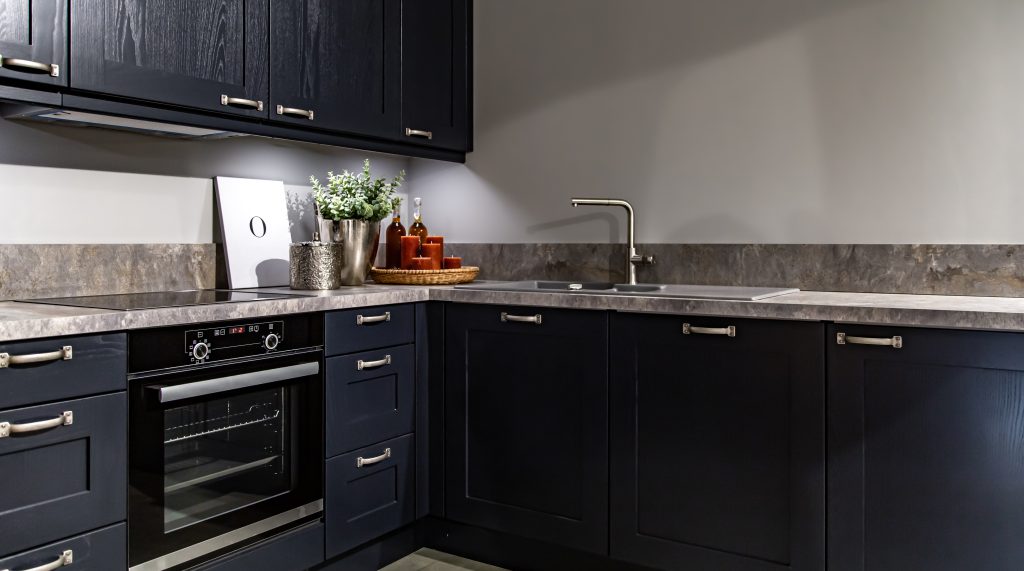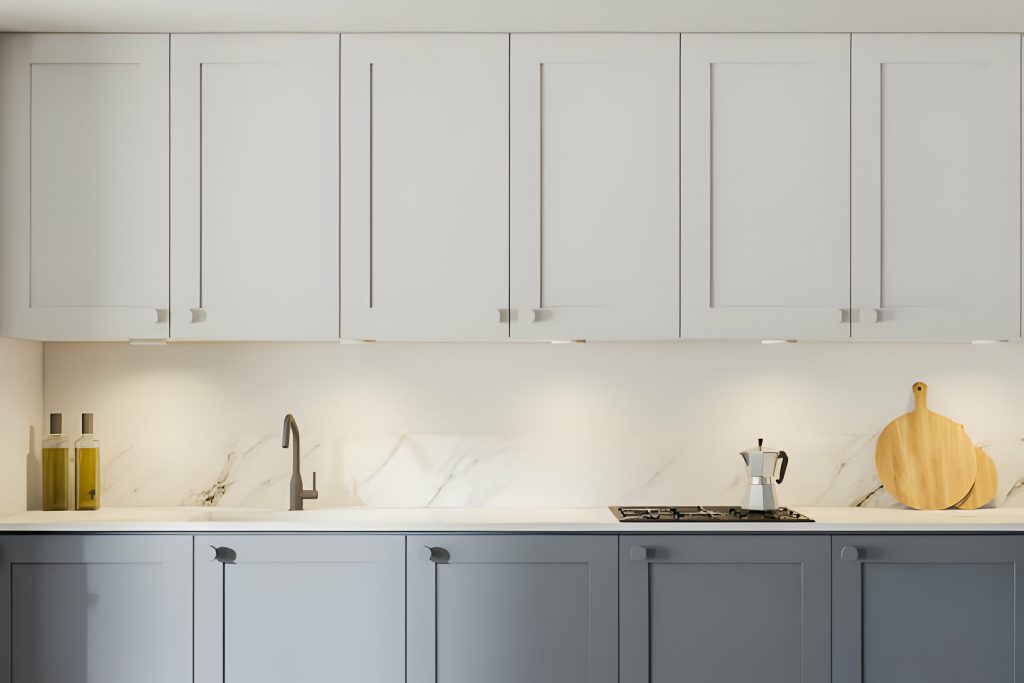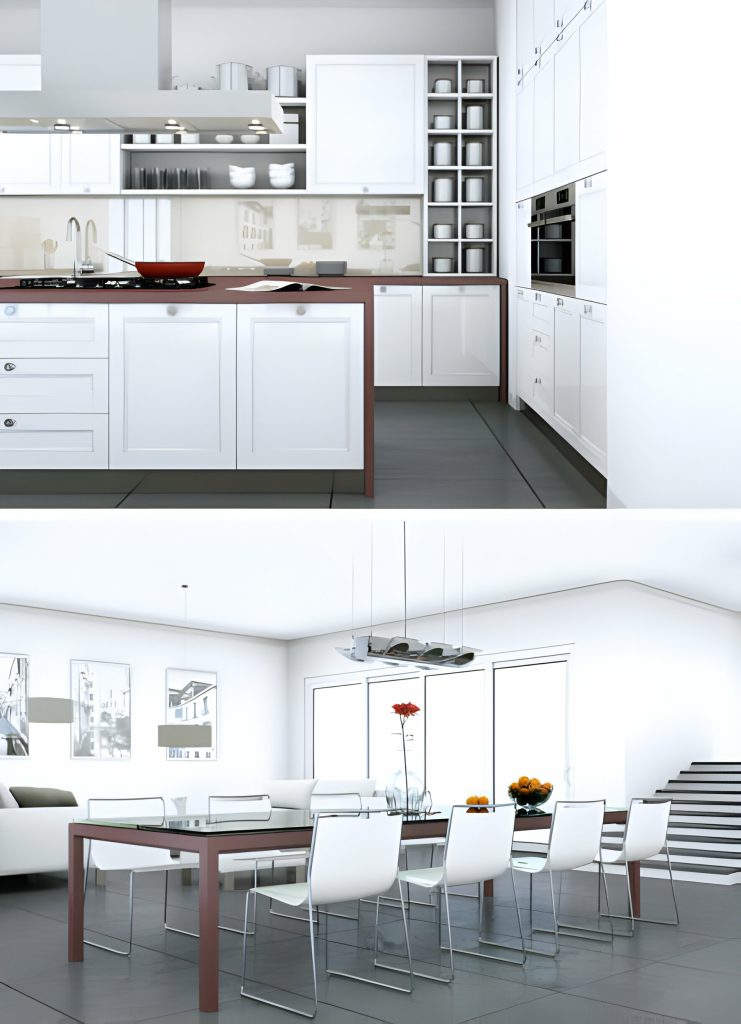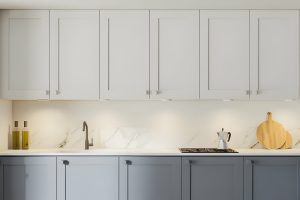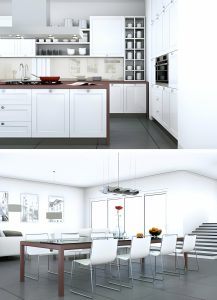The decision of whether to go darker or lighter than your walls can be a challenging one, but fear not! By considering various factors and understanding the impact of cabinet color on your kitchen’s overall aesthetic, you’ll be able to make an informed choice that perfectly suits your style and preferences. So, let’s dive in and explore the advantages of both options, as well as some stunning examples of light and dark kitchen designs that will inspire you to create the kitchen of your dreams.
Advantages of Lighter Cabinets
Lighter cabinets offer several advantages that can enhance the overall look and feel of your kitchen. When deciding between light and dark cabinets, there are a few key factors to consider. The first advantage of light cabinets is their ability to make a small kitchen appear larger and more spacious. This is especially beneficial for maximizing space in compact kitchens. Additionally, light cabinets reflect more natural light, creating a bright and airy atmosphere. This impact of natural light can make your kitchen feel inviting and refreshing.
In terms of design, light cabinets can be paired with white or light-colored backsplash, creating a cohesive and seamless look. This combination of colors can give your kitchen a clean and modern aesthetic. Furthermore, light cabinets provide a versatile backdrop for adding pops of color through accessories or decor. This allows you to personalize your kitchen and infuse it with warmth and personality.
Advantages of Darker Cabinets
When it comes to kitchen design, darker cabinets offer a striking contrast and a sense of depth that can elevate the overall aesthetic of your space. Here are the advantages of choosing darker cabinets for your kitchen:
- Design Impact: Darker cabinets create a bold statement and add character to your kitchen design. They can give your space a high-end and luxurious look, instantly elevating the style and sophistication.
- Color Psychology: Darker colors have psychological effects, such as creating a sense of warmth and coziness. Dark cabinets can add depth and richness to your kitchen, making it feel inviting and comfortable.
- Lighting Effects: Darker cabinets can interact with lighting in interesting ways. They can absorb light and create shadows, adding visual interest and dimension to your kitchen. Additionally, they can provide a contrasting backdrop for statement lighting fixtures, enhancing the overall aesthetic.
While darker cabinets have their advantages, it’s important to consider some cons as well. Darker cabinets can make a small kitchen appear smaller and may require more maintenance to keep them looking clean and free from scratches. It’s also crucial to consider the material of the cabinets, as darker colors can show more imperfections on certain surfaces. Ultimately, the decision between darker or lighter cabinets should be based on your personal preference and the desired look you want to achieve in your kitchen.
Examples of Light and Dark Kitchen Designs
To get a better understanding of how light and dark colors can be used in kitchen designs, let’s explore some examples that showcase the different effects and aesthetics that can be achieved. When it comes to light kitchen designs, opting for light cabinets with white or light-colored backsplash creates a clean and airy look. This not only makes a small kitchen appear larger, but also provides a refreshing feel to the space. To add warmth and personality, you can incorporate pops of color through accessories or decor.
On the other hand, dark kitchen designs create a bold and high-end look. Dark cabinets paired with light-colored countertops or backsplash create a visually striking contrast. Statement lighting fixtures and bold accessories can further enhance the overall aesthetic. The choice between light and dark cabinets ultimately depends on personal preference and desired look. There are no strict rules, so you have the freedom to choose what appeals to you.
When it comes to maximizing small kitchens, light tones are often recommended. Light walls and cabinets can make a small kitchen look bigger. Avoid filling the room with too many cupboards and use soft light woods and similar color walls and cupboards to create a harmonious and spacious feel. However, if you prefer a bolder look, you can create contrast by using darker cabinets with a lighter backsplash or accent wall.
In terms of creating a focal point, a darker island can make a statement in the kitchen. By limiting the darker shade to the island and pairing it with light, neutral cabinets, you can make the island stand out while maintaining a cohesive look. Another option is to create a wow-factor by painting both the walls and cabinets in the same dark color. This creates a cohesive and dramatic look, especially when paired with flashes of crystal and copper.
For those who prefer a more harmonious look, using similar tones can create a sophisticated finish. Subtle neutral tones have enduring appeal and can be combined by using darker and lighter shades of the same color. You can also choose complimentary tones when decorating with neutrals to create a cohesive and pleasing aesthetic.
Factors to Consider When Choosing Cabinet and Wall Colors
Now that you have explored different examples of light and dark kitchen designs, it’s important to consider various factors when choosing the colors for your cabinets and walls. To ensure a cohesive and visually pleasing kitchen design, there are several key factors to consider:
- Factors to consider: When choosing cabinet and wall colors, it’s essential to consider factors such as the impact of natural light, the size and layout of the room, other design elements like flooring and countertops, creating a cohesive design by considering complementary colors, and the overall color scheme of your home.
- Color psychology: Keep in mind the psychology of colors and how they can affect the mood and atmosphere of your kitchen. Lighter colors can create a bright and airy feel, while darker colors add depth and richness.
- Cohesive design: Aim for a cohesive design by selecting colors that work well together. Consider the overall color scheme of your home and choose cabinet and wall colors that complement each other. This will create a harmonious flow throughout your space.
Creating Contrast in Kitchen Design
Create a visually striking kitchen design by incorporating contrast into your space. One effective way to achieve this is by using light and dark colors in your kitchen cabinets and walls. The contrast between light and dark can create a dynamic and visually appealing look.
When incorporating contrast, consider the principles of color psychology. Lighter colors tend to create a sense of openness and brightness, while darker colors can add depth and richness. By utilizing light cabinets with a darker backsplash or accent wall, or vice versa, you can create a visually striking contrast that draws attention to different areas of your kitchen.
In addition to color, texture can also play a role in creating contrast. Consider incorporating different materials and finishes in your cabinets and walls. For example, pairing smooth, glossy cabinets with a textured, matte wall can create an interesting visual contrast.
Lighting is another important aspect to consider when creating contrast in your kitchen design. By strategically placing lighting fixtures, you can highlight certain areas and create focal points. For example, installing pendant lights above a dark kitchen island can draw attention to it and create a focal point in the space.
Personal Preference and Desired Look
When it comes to choosing the colors for your kitchen cabinets and walls, personal preference and desired look play a crucial role in creating a space that truly reflects your style and taste. Whether you prefer light or dark tones, the decision ultimately comes down to what you find visually appealing. Here are some considerations to keep in mind when making your choice:
- Color psychology: Lighter colors tend to create a sense of openness and airiness, while darker colors can add depth and richness to the space.
- Visual impact: Light cabinets can make a small kitchen appear larger, while dark cabinets can make a bold statement and add character to the design.
- Lighting considerations: Take into account the amount of natural light your kitchen receives. Light cabinets and walls can reflect more light, creating a bright and airy atmosphere, while dark cabinets may require additional lighting to prevent the space from feeling too dim.
Ultimately, your personal style preferences and desired look should guide your decision. Whether you opt for light or dark cabinets, the most important thing is to create a space that you love and that reflects your unique aesthetic.
Maximizing Space With Light Tones
To maximize the space in your kitchen, consider using light tones on your cabinets and walls. Light colors have the power to create an illusion of spaciousness, making your kitchen appear larger and more open. By blending colors that are similar in tone, you can create a cohesive design that flows seamlessly throughout the space.
Utilizing natural light is another key element in maximizing space. Light tones on your cabinets and walls help to reflect natural light, creating a bright and airy atmosphere. This not only enhances the overall aesthetic of your kitchen but also makes it feel more inviting and spacious.
Incorporating texture is another way to maximize space with light tones. By adding texture to your cabinets and walls, you can create visual interest and depth. Consider using materials like frosted glass, beadboard, or textured tiles to add dimension to your kitchen design.
Choosing accessories that complement your light-toned cabinets and walls is essential. Opt for accessories in neutral shades or soft pastels to maintain a cohesive look. Avoid overwhelming the space with too many bold colors or patterns, as this can make the kitchen feel cluttered and smaller.
Creating a Bold Look With Contrasting Tones
Now, let’s explore how you can make a bold statement in your kitchen by utilizing contrasting tones in your design. Creating a bold look with contrasting colors can have a powerful visual impact and transform your kitchen into a captivating space. Here are three ways you can achieve this:
- Dark cabinets with light walls: This high contrast combination creates a striking look that immediately draws attention. Pair dark cabinets in shades of grey, blue, or green with light-colored walls for a dramatic effect. The contrast between the two tones creates a sense of depth and adds a touch of sophistication to your kitchen.
- Light cabinets with a dark accent: Another way to create contrast is by using light cabinets with a darker accent. For example, you can have white or light-colored cabinets and incorporate a dark backsplash or accent wall. This creates a focal point and adds a bold element to your kitchen design.
- Contrasting colors for floor and wall cabinetry: To achieve a bold and unique look, consider using different colors for your floor and wall cabinetry. For instance, you can have one color for the lower cabinets and another color for the upper cabinets or walls. This creates a visually striking contrast and adds depth to your kitchen design.
